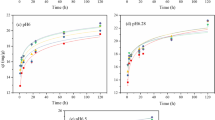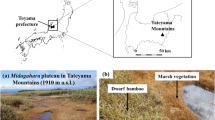Abstract
This paper aimed to investigate the variation of preserving organic matter bound in the interlayer space of montmorillonite (Mt) induced by a microbe metabolic process. We selected Bacillus pumilus as the common soil native bacteria. The alteration of d 001 value, functional group, and C,N organic matter contents caused by bacteria were analyzed by XRD, FTIR, and elementary analyzer, respectively. XRD results showed that the d 001 value of montmorillonite increased with the concentration decreasing and decreased with the culture time increasing after interacting with bacteria indicating the interlayer space of montmorillonite was connected with the organic matter. The findings of long-term interaction by resetting culture conditions implied that the montmorillonite buffered the organic matter when the nutrition was enough and released again when the nutrition was lacking. The results of the elementary analyzer declared the content of organic matter was according to the d 001 value of montmorillonite and N organic matter which played a major impact. FTIR results confirmed that the Si-O stretching vibrations of Mt were affected by the functional group of organic matter. Our results showed that the montmorillonite under the influence of soil bacteria has a strong buffering capacity for preserving organic matter into the interlayer space in a short-term. It might provide critical implications for understanding the evolution process and the preservation of fertilization which was in the over-fertilization or less-fertilization conditions on farmland.








Similar content being viewed by others
References
Ahmed E, Holmström SJM (2015) Microbe–mineral interactions: the impact of surface attachment on mineral weathering and element selectivity by microorganisms. Chem Geol 403:13–23
Alimova A, Katz A, Steiner N, Rudolph E, Wei H, Steiner JC, Gottlieb P (2009) Bacteria-clay interaction: structural changes in smectite induced during biofilm formation. Clay Clay Miner 57(2):205–212
Dai QW, Zhao YL, Dong FQ, Wang B, Huang YB (2014) Interaction between bentonite and Bacillus litoralis strain SWU9. Appl Clay Sci 100:88–94
Dong HL (2010) Mineral-microbe interactions: a review. Front Earth Sci-China 4(2):127–147
Ehlmann BL, Mustard JF, Fassett CI, Schon SC, Head JW III, Des Marais DJ, Grant JA, Murchie SL (2008) Clay minerals in delta deposits and organic preservation potential on Mars. Nat Geosci 1(6):355–358
Ehrlich HL (1996) How microbes influence mineral growth and dissolution. Chem Geol 132(1–4):5–9
Gong ZJ, Liao LB, Lv GC, Wang XY (2016) A simple method for physical purification of bentonite. Appl Clay Sci 119:294–300
Hatta T, Echigo T, Nemoto S, Tamura K, Yamada H (2011) Intercalation of sugar alcohols into the interlayer of montmorillonite by wet and dry processes. Clay Sci 15:61–66
He Y, Xu J, Wang H, Zhang Q, Muhammad A (2006) Potential contributions of clay minerals and organic matter to pentachlorophenol retention in soils. Chemosphere 65(3):497–505
Huang PM, Bollag JM, Huang PM, Senesi N, Buffle J (1998) Minerals-organics-microorganisms interactions in the soil environment. Comput Chem Eng 23(1):1–9
Hunter WR, Battin TJ (2016) Microbial metabolism mediates interactions between dissolved organic matter and clay minerals in streamwater. Sci Report 6:30971
Jiang W, Yang K, Vachet RW, Xing B (2010) Interaction between oxide nanoparticles and biomolecules of the bacterial cell envelope as examined by infrared spectroscopy. Langmuir 26(23):18071–18077
Kallenbach CM, Frey SD, Grandy AS (2016) Direct evidence for microbial-derived soil organic matter formation and its ecophysiological controls. Nat Commun 7:13630
Lin D, Ma WT, Jin ZX, Wang YX, Huang QY, Cai P (2016) Interactions of EPS with soil minerals: a combination study by ITC and CLSM. Colloid Surf B 138:10–16
Liu D, Dong HL, Bishop ME, Zhang J, Wang H, Xie S, Wang S, Huang L, Eberl DD (2012) Microbial reduction of structural iron in interstratified illite-smectite minerals by a sulfate-reducing bacterium. Geobiology 10(2):150–162
Mueller B (2015) Experimental interactions between clay minerals and bacteria: a review. Pedosphere 25(6):799–810
Pannirselvam M, Gupta RK, Bhattacharya SN, Shanks RA (2007) Intercalation of montmorillonite by interlayer adsorption and complex formation. Adv Mater Res 29-30:295–298
Parkes JR (1998) Geomicrobiology: interactions between microbes and minerals. Mineral Mag 62(5):725–726
Pearson VK, Sephton MA, Kearsley AT, Bland PA, Franchi IA, Gilmour I (2002) Clay mineral-organic matter relationships in the early solar system. Meteorit Planet Sci 37(12):1829–1833
Peinemann N, Amiotti NM, Zalba P, Villamil MB (2000) Effect of clay minerals and organic matter on the cation exchange capacity of silt fractions. J Plant Nutr Soil Sci 163(1):47–52
Spence A, Robinson C, Hanson RE (2014) The effects of microstructural changes on montmorillonite–microbial interactions. J Mol Struct 1056-1057:157–165
Swann GEA, Patwardhan SV (2010) Application of Fourier Transform Infrared Spectroscopy (FTIR) for assessing biogenic silica sample purity in geochemical analyses and palaeoenvironmental research. Clim Past Discuss 6(5):1629–1653
Thuc C-NH, Grillet A-C, Reinert L, Ohashi F, Thuc HH, Duclaux L (2010) Separation and purification of montmorillonite and polyethylene oxide modified montmorillonite from Vietnamese bentonites. Appl Clay Sci 49:229–238
Tisato N, Torriani SF, Monteux S, Sauro F, Waele JD, Tavagna ML, D’Angeli IM, Chailloux D, Renda M, Eglinton TI, Bontognali TR (2015) Microbial mediation of complex subterranean mineral structures. Sci Report 5:15525
Vorhies JS, Gaines RR (2009) Microbial dissolution of clay minerals as a source of iron and silica in marine sediments. Nat Geosci 2(3):221–225
Yang XX, Li Y, Lu AH, Wang HR, Zhu Y, Ding HR, Wang X (2016) Effect of Bacillus mucilaginosus D4B1 on the structure and soil-conservation-related properties of montmorillonite. Appl Clay Sci 119:141–145
Yesiltas M, Kebukawa Y (2016) Associations of organic matter with minerals in Tagish Lake meteorite via high spatial resolution synchrotron-based FTIR microspectroscopy. Meteorit Planet Sci 51(3):584–595
Yu BS, Dong HL, Han PY (2012) Experimental research on microbial degradation of organic matter adsorbed in smectite internal surface area in the interlayer of the structure. Acta Petrol Sin 28(3):949–960
Zeng Q, Dong HL, Zhao LD, Huang QY (2016a) Preservation of organic matter in nontronite against iron redox cycling. Am Mineral 101:120–133
Zeng LL, Hong ZS, Wang C, Yang ZZ (2016b) Experimental study on physical properties of clays with organic matter soluble and insoluble in water. Appl Clay Sci 132:660–667
Zhang J, Dong HL, Zeng Q, Agrawal A (2014) The role of Fe(III) bioreduction by methanogens in the preservation of organic matter in smectite. Chem Geol 389:16–28
Zhang G, Kim J, Dong HL, Sommer AJ (2016) Microbial effects in promoting the smectite to illite reaction: role of organic matter intercalated in the interlayer. Am Mineral 92(8–9):1401–1410
Zhao YL, Dai QW, Dong FQ, Han LB, Dang Z (2017) Microbially retention process of Sr(II) ions mediated by metabolite and putrefaction in montmorillonite-Pseudomonas fluorescens aqueous system. J Nanosci Nanotechnol 17:6597–6602
Zhu Y, Li Y, Lu AH, Wang HR, Yang XX, Wang CQ, Cao WZ, Wang QH, Zhang XL, Pan DM, Pan XH (2011) Study of the interaction between bentonite and a strain of Bacillus Mucilaginosus. Clay Clay Miner 59(5):538–545
Acknowledgements
This work is supported by the National Natural Science Foundation of China (No. 41130746), the Natural Science Foundation of Southwest University of Science and Technology (No. 12ZX7121), and the Applied Basic Research Project of Science and Technology Department of Sichuan Province (No. 2016JY0213). We also are grateful for the help of the Analytical and Testing Center of Southwest University of Science and Technology.
Author information
Authors and Affiliations
Corresponding author
Additional information
Responsible editor: Philippe Garrigues
Rights and permissions
About this article
Cite this article
Zhao, Y., Dong, F., Dai, Q. et al. Variation of preserving organic matter bound in interlayer of montmorillonite induced by microbial metabolic process. Environ Sci Pollut Res 25, 22348–22355 (2018). https://doi.org/10.1007/s11356-017-9806-7
Received:
Accepted:
Published:
Issue Date:
DOI: https://doi.org/10.1007/s11356-017-9806-7




